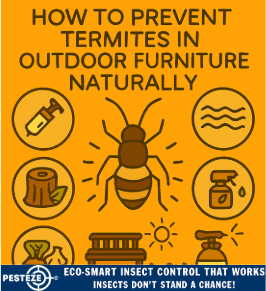HOW TO PREVENT TERMITES IN OUTDOOR FURNITURE NATURALLY

HOW TO PREVENT TERMITES IN OUTDOOR FURNITURE NATURALLY
SUMMARY
Outdoor wooden furniture is highly vulnerable to termite infestations due to constant exposure to weather, soil, and moisture. Termites can quickly weaken chairs, tables, and benches, leading to costly replacements. With the right preventive steps, you can protect your outdoor furniture and extend its life without resorting to harsh chemicals.
FEATURES
-
Seal and Treat Wood – Apply protective coatings, oils, or sealants regularly.
-
Keep Furniture Dry – Avoid damp conditions that attract termites.
-
Use Natural Repellents – Orange oil, neem oil, and clove oil deter termites safely.
-
Elevate Furniture – Keep wood off direct soil contact with stands or pads.
-
Clean and Maintain Regularly – Wipe surfaces, check for damage, and reapply protection.
-
Store Furniture Seasonally – Use covers or indoor storage during wet months.
GUIDE DESCRIPTION
Outdoor wooden furniture enhances patios and gardens, but it’s also a prime target for termites. Because these pests thrive in damp, unprotected wood, preventive care is essential for keeping your furniture termite-free.
Start with sealing and treating wood. Apply weather-resistant sealants, stains, or natural oils like tung or linseed oil. This creates a barrier that protects furniture from moisture and makes it less attractive to termites. Reapply treatments every season or as recommended for your climate.
Moisture is the main draw for termites, so keeping furniture dry is crucial. Place pieces in shaded, well-ventilated areas where they dry quickly after rain. Use covers during wet conditions, but ensure they allow air circulation to avoid trapping humidity.
For natural protection, essential oils such as orange, neem, and clove work as termite deterrents. Mix a few drops with water in a spray bottle and apply to furniture surfaces regularly. These eco-friendly repellents are safe for families and pets while providing added defense.
Another key step is to elevate furniture. Keep legs and bases from resting directly on soil by using pads, stone slabs, or stands. This reduces termite access and limits the risk of infestation from the ground.
Routine cleaning and maintenance also make a big difference. Wipe furniture to remove debris, check joints and corners for early signs of termite activity, and refresh protective coatings as needed. Early detection helps prevent infestations from spreading.
Finally, consider seasonal storage. During rainy or humid months, store furniture indoors or under a dry, covered area. If storage isn’t possible, invest in breathable furniture covers to shield against weather and pests.
By sealing wood, controlling moisture, applying natural repellents, elevating furniture, maintaining cleanliness, and storing pieces properly, you can prevent termites from damaging your outdoor furniture. These steps ensure your investment stays durable and beautiful for years to come.
- Shashank Rongali


Comments 0